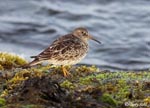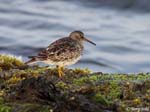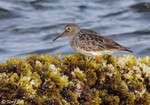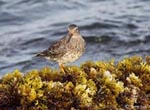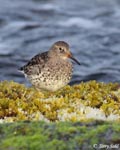Purple Sandpiper
Calidris maritima
| Length: 9 inches | Wingspan:17 inches | Seasonality: Extremely rare visitor |
| ID Keys: Chunky body shape, orange legs and base of bill, overall gray in nonbreeding plumage, bit of rufous on upperside in breeding plumage | ||
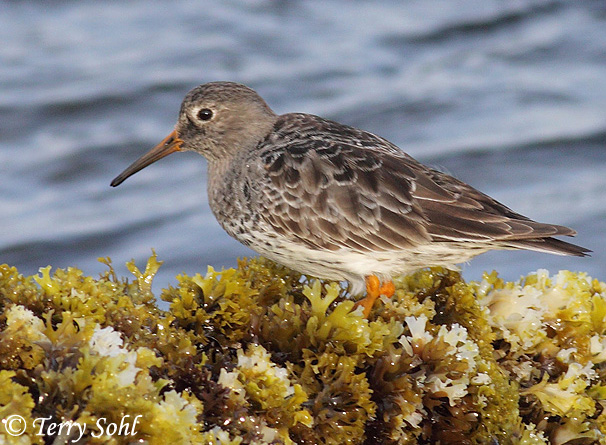 The
Purple Sandpiper is most often seen along the shoreline of the northeastern U.S.
and eastern Canada in winter, when the tough chunky birds are found around the
pounding surf on rocky shores. It survives the winter in these conditions
that are further north on the Atlantic Coast than any other shorebird.
Its breeding grounds are remote and seldom visited. It is very similar to
the Rock Sandpiper, the species' equivalent on the West Coast.
The
Purple Sandpiper is most often seen along the shoreline of the northeastern U.S.
and eastern Canada in winter, when the tough chunky birds are found around the
pounding surf on rocky shores. It survives the winter in these conditions
that are further north on the Atlantic Coast than any other shorebird.
Its breeding grounds are remote and seldom visited. It is very similar to
the Rock Sandpiper, the species' equivalent on the West Coast.
Habitat: On its wintering grounds, nearly always found on rocky shorelines, rocky jetties, etc. In summer, Purple Sandpipers are found on the tundra, most often in rocky areas.
Diet: Primariliy feeds on insects during the summer breeding season, as well as other invertebrates. During migration and on its wintering grounds, feeds on mollusks, crustaceans, and insects. They will also occasionally feed on plant material, such as seeds, leaves, moss, and berries.
Behavior: Purple Sandpipers are most often sighted in small groups clambering on rocky shores, deftly avoiding the incoming surf by hopping to higher perches when necessary. Will also sometimes forage on open areas such as beaches.
Nesting: Ground-nester on the open tundra of northern Canada, typically in a mossy or lichen-covered area.
Breeding Map: Non-breeder in South Dakota
Song: The typical flight call is a harsh, low keech. When on the summer breeding grounds, males will give a wheezy, uneven trilling.
Migration: Summers in the far northern reaches of Canada. Winters further north than any other shorebird on the Atlantic Coast, from eastern Canada southward to the Carolinas.
Interactive eBird Map: Click here to access an interactive eBird map of Purple Sandpiper sightings
Similar Species: Dunlin
Conservation Status: Numbers appear to be stable or increasing. May have benefited from the construction of rocky jetties and other structures along the Atlantic shoreline, as they provide more suitable wintering habitat.
Further Information: 1) Patuxent Bird Identification InfoCenter: Purple Sandpiper
2) Whatbird.com: Purple Sandpiper
3) Audubon Guide - Purple Sandpiper
Photo Information: Photo taken on April 12th, 2012 - Sachuest National Wildlife Refuge, Rhode Island - Terry Sohl
| Click on the map below for a higher-resolution view |
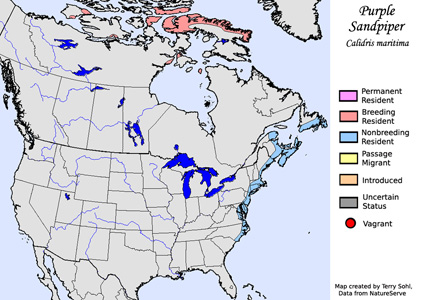 |
| South Dakota Status: Species is considered "hypothetical" in South Dakota, meaning a sighting has never been confirmed, but it is considered a possible, extremely rare vagrant. |
Additional Purple Sandpiper Photos
Click for a higher-resolution version of these photos
